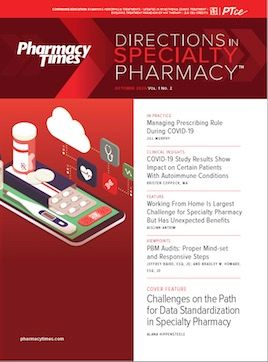Publication
Article
Specialty Pharmacy Times
Patient Considerations When Approaching Immunoglobulin Treatment
Author(s):
Key Takeaways
- Immunoglobulin therapy is used for diseases like chronic lymphocytic leukemia and autoimmune disorders, with replacement and immunomodulation approaches based on disease type.
- Ig therapy, though not FDA-indicated for organ transplants, can reduce human leukocyte antigen antibodies, aiding in transplant success.
Providers must account for important considerations when choosing the appropriate therapy for each patient based on their specific needs.
Immunoglobulin (IG), an antibody found in the plasma portion of the blood, is used for the treatment of multiple disease states. According to a session at the 2020 National Association of Specialty Pharmacy Annual Meeting & Expo Virtual Experience, providers must account for important considerations when choosing the appropriate therapy for each patient based on their specific needs.1
During a session on the state of Ig care in 2020, Allan Tsao, DPh, RPh, infusion program director at US Bioservices , explained that the FDA has currently approved Ig for treating diseases such as chronic lymphocytic leukemia (CLL), chronic B-cell lymphocytic leukemia , common variable immunodeficiency, chronic inflammatory demyelinating polyneuropathy, immune-mediated thrombocytopenia, idiopathic thrombocytopenia purpura, Kawasaki disease, pediatric HIV type 1 infection , and multifocal motor neuropathy.
Ig is effective for these diseases because the immune system can use it to neutralize pathogens, such as pathogenic bacteria, fungi, and viruses. Subclasses of Ig also exist and are classified into IgA, IgD, IgE, IgG, and IgM. Among these, IgG has 4 additional subclasses, named in order of increasing abundance, IgG1, IgG2, IgG3, and IgG4.
Providers use 2 main approaches to Ig treatment for different disease types, according to Tsao. For immunodeficiencies, they use replacement therapy because in these cases, the body is producing insufficient or nonfunctioning immunoglobulins. This occurs most commonly because of the presence of other conditions, such as CLL, or following a bone marrow transplant. In these situations, replacement therapy allows the body to more effectively fight infections.
In cases of autoimmune disorders, immunomodulation therapy is used because of its multiple complex and complementary mechanisms of actions. According to Tsao, this therapy type allows for the neutralization of pathogenic autoantibodies by antiidiotypic antibodies , as well as the down-regulation of antibody production . This then allows for the suppression of pathogenic cytokine and the inhibition of superantigens.
Additionally, providers commonly use some of these therapies for non—FDA-indicated conditions. Tsao explained that Ig is commonly used for neonatal alloimmune thrombocytopenia, myasthenia gravis, Guillain-Barré syndrome, stiff person syndrome, pemphigus, pemphigoid, polymyositis, dermatomyositis, immune-mediated necrotizing myopathy, and before and after organ transplants.
Tsao noted that despite Ig not being indicated by the FDA for use before or after an organ transplant, Ig is able to lower the level of human leukocyte antigen antibodies, hindering their ability to attack the transplanted organ . This ability makes Ig a valuable component in treating patients and helping them reach successful outcomes following transplant, according to Tsao.
Despite the potential for successful patient outcomes following treatment with Ig, providers must still consider issues related to patients’ quotidian lives, as Ig is often a lifelong treatment commitment. This makes the decision between intravenous immunoglobulin (IVIg) and subcutaneous immunoglobulin (SCIg) infusions critical for patients in how often they will need to receive treatment.
“For IVIg, the frequency is a little bit less than about once a month, or every 3 to 4 weeks, as opposed to SCIg, where you need to be [giving treatments] a little bit longer and a little more frequently—sometimes every few days,” Tsao said. “However, on the Ig level, [with IVIg] you get a little bit of a higher spark and a lower trough, and also you have the wearing-off effect between infusions because the duration of the infusion is usually a bit longer, maybe once a month, as opposed to a more consistent level on the SCIg, as it’s being used more frequently. [With SCIg] once the Ig level reaches a steady state, it is usually pretty stable throughout.”
Tsao also explained that IVIg also leads to some common systemic adverse effects (AEs) but that local reactions to treatment are uncommon. However, with SCIg, systemic AEs are rare, whereas local reactions are common. To manage the AEs associated with IVIg, providers commonly use premedication, which is also less necessary for SCIg.
Additionally, Tsao noted that the cost of therapy is something to consider for patients, as IVIg has a higher associated cost because of the need for nursing support, whereas SCIg has lower associated costs because self-administration of the infusion is a possibility for patients.
“Obviously, with needing nursing support to do the infusion [for IVIg], you have that consideration. For SCIg, when the patient is taught and trained how to provide self-infusion, the cost of therapy is basically down to the drug and the supply itself,” Tsao said. Tsao explained further that when considering IVIg versus SCIg, although patients tolerate both infusions well, patients with IVIg infusions cannot achieve independence. Although this may make clinical monitoring easier for providers, it will have other effects on the lives of patients.
“Clinical monitoring, from my perspective, will probably be easier when you have a nurse or a nursing agency that could report consistently on how things are going, as opposed to [patients on] SCIg, [who] will have to depend on the patient to provide updates on how they’re doing,” Tsao said.
With SCIg, independence is possible because of patients’ ability to self-administer the infusion following proper training. Although this can make clinical monitoring potentially more difficult for providers depending on the patient, it may benefit patients because they will have more independence and flexibility around their treatments.
REFERENCE
- Sheets J, Tsao A. State of care 2020: immunoglobulin. Presented at: National Association of Specialty Pharmacy Annual Meeting & Expo Virtual Experience; September 14-18, 2020. Accessed September 16, 2020. https://nasp.6connex.com/event/VirtualExperience/en-us#!/Lobby

Newsletter
Stay informed on drug updates, treatment guidelines, and pharmacy practice trends—subscribe to Pharmacy Times for weekly clinical insights.






